

Assessment in Project Based Learning. Edmodo: The Classroom Hub for Project-Based Learning. Edmodo is becoming an indispensable tool in many classrooms engaged in project based learning, to help with project management and assessment.
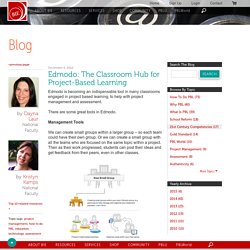
There are some great tools in Edmodo. Management Tools We can create small groups within a larger group – so each team could have their own group. Or we can create a small group with all the teams who are focused on the same topic within a project. Then as their work progressed, students can post their ideas and get feedback from their peers, even in other classes. The Library allows us to share links and documents with students. The latest version of Edmodo has “backpacks” where students can organize and store their own resource materials.
Project Based Learning. Resource List: Assessment in PBL. 21st Century Skills Assessment. How to Get High-Quality Student Work in PBL. “I thought the project was going well… but by the end, I felt that the work my students produced was not as good as I imagined it would be.

I was a little embarrassed and almost wanted to dial back the audience’s expectations on the night of the presentations!” This is a common concern of teachers who are new to Project Based Learning. Things can appear to be going smoothly; students have been engaged by the project, they've been learning content and skills, they've been busy and meeting deadlines… but their thinking is not as in-depth and their final products not as polished as they should be. If this is your experience, it’s time to ask yourself some questions: 1. Hangout Recap: Assessing 21st Century Competencies in PBL. For our Hangout on April 16, 2014, we were joined by educator Laura Greenstein, author of Assessing 21st Century Skills: A Guide to Evaluating Mastery and Authentic Learning (Corwin, 2012) and David Grant, a teacher and digital technology specialist at King Middle School in Portland, Maine, and Director of Video at Expeditionary Learning.

What are the challenges of assessing 21c competencies? Laura said one challenge is the diversity of learning outcomes; is it a performance, a demonstration, the creation of an artifact? Also challenging is what the psychometricians are concerned with: the technical quality of the assessment, its reliability and validity. David noted that Expeditionary Learning (EL) schools look at assessing standards-aligned learning primarily, and many EL schools separate content from 21st century competencies, aka “habits of work & learning” which are assessed separately, and self-assessed by students. Sample Project Assessment Map. Rubric for Rubrics. 6-8 Presentation Rubric (CCSS Aligned) How to Use the “4 C’s” Rubrics. This excerpt appears in the Buck Institute for Education's book, "PBL for 21st Century Success: Teaching Critical Thinking, Collaboration, Communication, Creativity.
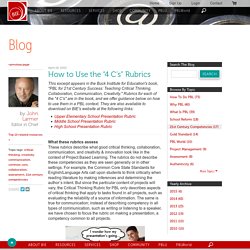
" Rubrics for each of the "4 C's" are in the book, and we offer guidance below on how to use them in a PBL context. They are also available to download on BIE's website at the following links: What these rubrics assess These rubrics describe what good critical thinking, collaboration, communication, and creativity & innovation look like in the context of Project Based Learning. Resource List: Critical Thinking in PBL.
Resource List: Collaboration in PBL. Resource List: Communication in PBL. Resource List: Creativity in PBL. Embedded Critical Thinking Throughout PBL. 6-12 Critical Thinking Rubric (CCSS Aligned) What Does It Take for a Project to be “Authentic”? UPDATE: Has what it takes for a project to be "authentic" changed given the new Gold Standard PBL?
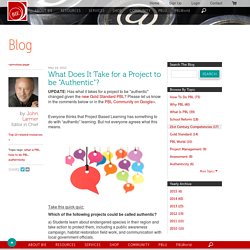
Please let us know in the comments below or in the PBL Community on Google+. Everyone thinks that Project Based Learning has something to do with “authentic” learning. But not everyone agrees what this means. Take this quick quiz: Which of the following projects could be called authentic? A) Students learn about endangered species in their region and take action to protect them, including a public awareness campaign, habitat restoration field work, and communication with local government officials. b) Students design and create a calendar with pictures and information about endangered species, which they sell at a pre-winter break community event and donate the money to an environmental organization. c) Students play the role of scientists who need to make recommendations to an environmental organization about how to protect endangered species in various ecosystems around the world. 1. 2. 3.
Project Based Learning. We’re going to share some advice about how to manage projects, at both the secondary and elementary levels.

Projects have lots of moving parts, so we’ll highlight a few key elements and share some best practices. Launch your Project with an Entry Event Rather than simply announce a project, we can generate interest by creating a special event that takes our class out of their routine, and lets them know something special is about to happen. Entry events should engage and intrigue, and provoke students to want to know more. We avoid pre-teaching important content, because we have not yet created that need to know. After the entry event, the students should have a need to know more. Create Teams to do the Work When creating project teams, four is often the best number.
It is usually best to have heterogeneous groups, and the teacher should help set them up. We often assign students special roles within a team, related to the real world jobs that would be required to complete the project. The Role of PBL in Making the Shift to Common Core. “CCSS is the what and carefully designed projects are the how.”
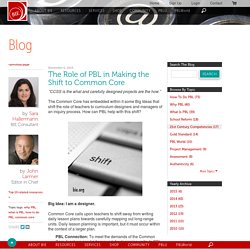
The Common Core has embedded within it some Big Ideas that shift the role of teachers to curriculum designers and managers of an inquiry process. How can PBL help with this shift? Big Idea: I am a designer. Common Core calls upon teachers to shift away from writing daily lesson plans towards carefully mapping out long-range units. Daily lesson planning is important, but it must occur within the context of a larger plan.
PBL Connection: To meet the demands of the Common Core, teachers need a framework for designing units. Big Idea: I facilitate inquiry. Research and sustained inquiry are emphasized throughout the standards, but most prominently in the writing strand because written analysis and presentation of findings are critical in both college and careers. CCSS Performance Tasks and PBL. The Common Core is the “what.” PBL is the “how.” About a year ago I wrote a blog that detailed explicit connections between the 8 Essentials Elements of Project Based Learning and the Common Core.

Not a lot of educators tuned in. Can you hear me now? I guess you have a Need to Know. Forty-five states have signed on to the Common Core. Louisiana is first out of the gate and will begin implementing the Common Core in the 2012-2013 school year, with the expectation of full implementation in the 2014-2015 school year. PARCC is scheduled to make its performance task items available this summer following a pilot in the spring that targeted large urban districts (New York, Washington DC, Albuquerque, Atlanta, Boston, Cleveland, Philadelphia and St. To the PBL world, the most interesting of these locations is New York. Smarter Balanced, which awarded a contract in April to a design and development group led by CTB/McGraw Hill, plans on a January 2013 pilot of its test items/tasks. Search Results.
Students and Audience in Project Assessment. Here are some highlights of the Oct. 3, 2012 webinar, Project Assessment.
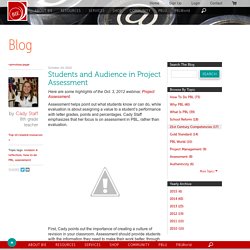
Assessment helps point out what students know or can do, while evaluation is about assigning a value to a student’s performance with letter grades, points and percentages. Cady Staff emphasizes that her focus is on assessment in PBL, rather than evaluation. First, Cady points out the importance of creating a culture of revision in your classroom. Assessment should provide students with the information they need to make their work better, through kind, helpful, specific and timely feedback.